Magpie
lab constructor
    
Posts: 5939
Registered: 1-11-2003
Location: USA
Member Is Offline
Mood: Chemistry: the subtle science.
|
|
preparation of naphthionic acid
Introduction
Napthionic acid can be prepared from α-nitronaphthalene using the Piria reaction (ref 1). This is a two-step synthesis. The overall reaction is
shown below:

Piria reaction equation
The expected yield is 20-30%. The reason for this low yield is explained below in the Discussion section.
Experimental
a. reaction set-up
The reaction was carried out in a 2-neck 250ml RBF equipped with a heating mantle, an overhead mixer, and a reflux condenser as shown below:
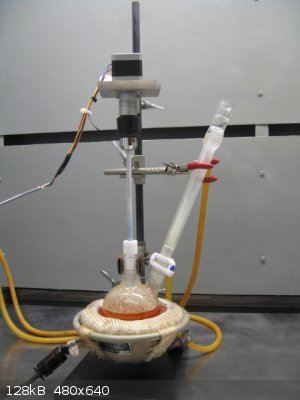
Na naphthionate rx vessel
84.4ml of water, 67.3ml of 5.2M sodium bisulfite, and 11.4g of α-nitronaphthalene were added to the RBF. The sodium bisulfite was made up from
sodium metabisulfite (Brewcraft). The α-nitronaphthalene was homemade (ref 2).
The mixer was set at 205.5 rpm and the mixture kept at boiling until it was homogeneous. Reference 1 indicated that the heating time without mixing
would be ~5 hours or ~half that if mixing was used. The mix looked homogeneous after 3 hours but I continued the heating/stirring for a total of 4.5
hours for my convenience. The reaction product is shown below:
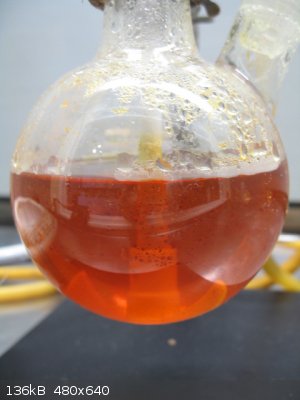
Na naphthionate reaction product
b. product volume reduction
The reaction vessel was then set up for simple distillation to achieve a volume reduction of 25% per the Kline procedure. 37.8mL of cloudy water was
removed from the product.
The cloudy distillate not only looked like a steam distillate but also came over to the receiver like one, ie, in spurts. I speculate that the
entrained light white material was naphthalene and/or unreacted α-nitronaphthalene. This was discarded.
Attachment: phpYxzGHO (142kB)
This file has been downloaded 644 times
distillation volume reduction
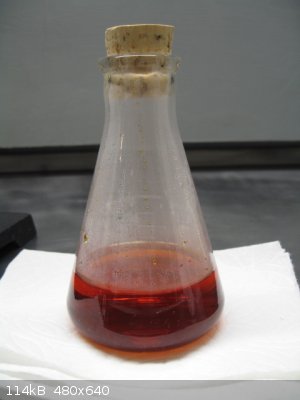
product after volume reduction
c. acidification
The second step of the Piria reaction is acidification. For this 23.6mL of con HCl was added to the above product. This resulted in the formation of
a heavy white precipitate of napthionic acid as it is insoluble in water. This is shown below:
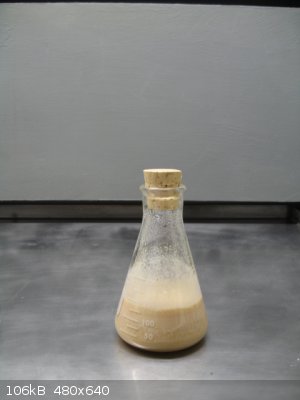
Napthionic acid
d. washing, filtration, and drying
After cooling and setting overnight the napthionic acid suspension was first mixed with 100mL of boiling water. It was then filtered using a 7cm
Buchner funnel to remove the soluble salts, both organic (sodium aminodisulfonate) and inorganic. The cake was then washed with ~100ml of cold water
and then sucked to the consistency of a wet mud. This mud, which is white with a pink cast, was placed on a plate to air dry overnight.
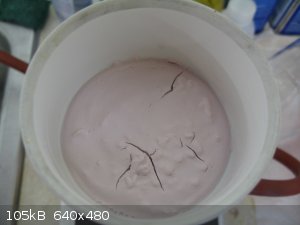
Napthionic acid cake on Buchner funnel
Results
The mp of naphthionic acid is reported to be > 300°C and I made no attempt to determine it. The yield was 3.5g, or 23.0%, which is in the
expected range of 20-30%.
Discussion
The Kline procedure refers to a JACS article (ref 3) about the Peria reaction. The JACS article states that for the above synthesis most of the
product is sodium aminodisulfonate, ie, 66% in their experiment. This explains the expectation for a low yield of the target product sodium
napthionate.
The sodium napthionate is converted to napthionic acid by acidifying with HCl in the 2nd step of the Piria reaction.
Safety
NaHSO3 is used in 75% excess in this preparation. SO2 gas is released during the acidification step with con HCl, and in transfers. These steps
should be performed in a fume hood or outside.
References
1. “CONGO RED,” Journal of Chemical Education, by E. R. Kline, pp. 129-131 (March1938).
2. http://www.sciencemadness.org/talk/viewthread.php?tid=66288
3. “THE PIRIA REACTION,” Journal of the American Chemical Society, by Hunter, W. H. and Murray M. Sprung, 53, p.
1432-1443 (Apr 1931)
Question, comments, and suggestions are welcomed.
[Edited on 27-5-2016 by Magpie]
[Edited on 27-5-2016 by Magpie]
[Edited on 27-5-2016 by Magpie]
The single most important condition for a successful synthesis is good mixing - Nicodem
|
|
|
aga
Forum Drunkard
    
Posts: 7030
Registered: 25-3-2014
Member Is Offline
|
|
Wonderful !
I love your photo-illustrated and well written-up synths Magpie.
You're an inspiration.
Any intended purpose for the naphthionic acid ?
|
|
|
Magpie
lab constructor
    
Posts: 5939
Registered: 1-11-2003
Location: USA
Member Is Offline
Mood: Chemistry: the subtle science.
|
|
Thanks aga. Yes, this will be used to make congo red, an acid-base indicator that changes from blue to red at pH 3.0–5.2.
The single most important condition for a successful synthesis is good mixing - Nicodem
|
|
|
aga
Forum Drunkard
    
Posts: 7030
Registered: 25-3-2014
Member Is Offline
|
|
Synths like this keep SM interesting.
Arses need to get in gear and actually Do stuff (my own arse included).
Did you buy the α-nitronaphthalene or can it be produced ? (suspect the latter).
|
|
|
Magpie
lab constructor
    
Posts: 5939
Registered: 1-11-2003
Location: USA
Member Is Offline
Mood: Chemistry: the subtle science.
|
|
The α-nitronaphthalene was homemade (ref 2).
The single most important condition for a successful synthesis is good mixing - Nicodem
|
|
|
aga
Forum Drunkard
    
Posts: 7030
Registered: 25-3-2014
Member Is Offline
|
|
Of course. Sorry.
Better link:
http://www.sciencemadness.org/talk/viewthread.php?tid=66288
Let's see if Spain has mothballs. If so, i'll try and catch up.
[Edited on 27-5-2016 by aga]
|
|
|
blogfast25
International Hazard
    
Posts: 10562
Registered: 3-2-2008
Location: Neverland
Member Is Offline
Mood: No Mood
|
|
Careful because some mothballs are sold as naphthalene but really are camphor. Been there, I'm afraid.
Check MP on receipt of goods.
|
|
|
aga
Forum Drunkard
    
Posts: 7030
Registered: 25-3-2014
Member Is Offline
|
|
Note to self: take the reading glasses to the supermarket.
|
|
|
gdflp
Super Moderator
      
Posts: 1320
Registered: 14-2-2014
Location: NY, USA
Member Is Offline
Mood: Staring at code
|
|
I just finished drying my run of naphthionic acid and was about to do a quick writeup when I saw this thread! I guess the timing worked out well,
might as well post what I've got.
<b>Experimental</b>
4.7g of α-nitronapthalene was placed in a 250ml flask. This was a slightly darker yellow than pure α-nitronaphthalene, but as the paper mentioned
above(Magpie's ref. 1) uses the nitro compound crude and this was recrystallized once, it was deemed pure enough.
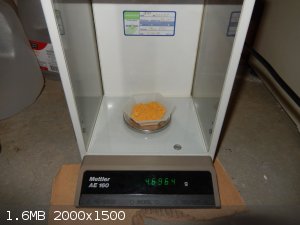
<i>α-nitronapthalene</i>
13.23g of Na<sub>2</sub>S<sub>2</sub>O<sub>5</sub> were then weighed out and dissolved in 50ml of distilled water.
This solution was then added to the flask containing the nitro compound and a condenser was attached.
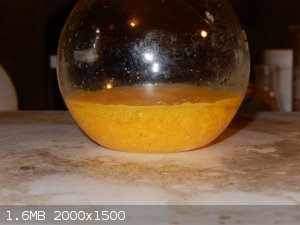
<i>Reaction mixture prior to heating</i>
The mixture was heated to reflux with magnetic stirring, at which point it was noted that the nitronaphthalene melted and floated above the aqueous
layer. Complete dissolution occurred after about 4 hours, and heating was continued for another half hour to ensure complete reaction.
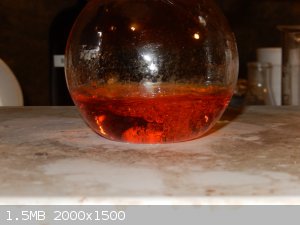
<i>Reaction mixture refluxing near the end of the reaction</i>
The mixture was then allowed to cool slightly below reflux, at which point the condenser was removed and heating was reapplied until approximately one
quarter of the solution had evaporated.
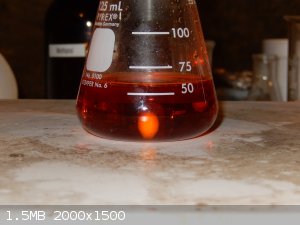
<i>Reaction mixture prior to evaporating water</i>
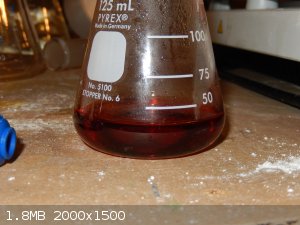
<i>Reaction mixture after evaporating water</i>
11ml of 32% hydrochloric acid were then added(This slightly more dilute acid was used because I didn't have conc. HCl on hand) while the mixture was
still hot. This resulted in effervescence of some SO<sub>2</sub>, thus this preparation should be conducted in a well ventilated area.
Immediate precipitation of a tan solid was noted. The solution was then left to cool down to room temperature, at which point it had nearly
completely solidified.
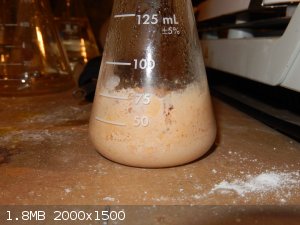
<i>Acidified reaction mixture cooled to room temperature</i>
Since the mixture was not filterable at this point, 40ml of hot water(This water is used in ref. 1 to wash the product in the funnel) were added and
the mixture was shaken vigorously until the solid was broken up enough for the magnetic stir bar to be freed, at which point the mixture was stirred
for several minutes.
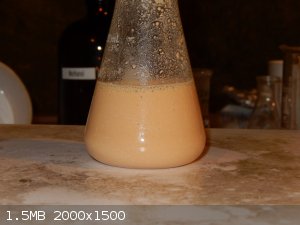
<i>Naphthionic acid suspended in water</i>
The solution was then vacuum filtered and the solid was washed with an additional 15ml of distilled water.
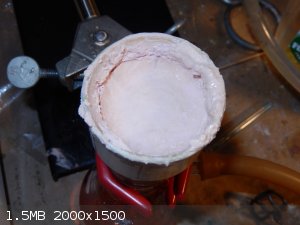
<i>Naphthionic acid filter cake</i>
This was allowed to dry in the funnel overnight, at which point it was removed, then placed on a watch glass. This was then placed on a hot plate at
140°C surface temperature for several hours to dry completely, then ground into a powder, yielding 3.62g of naphthionic acid as a pale pink/tan
powder.
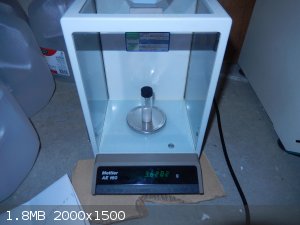
<i>Final product of naphthionic acid</i>
<b>Discussion</b>
The yield for this reaction was 3.62g or 59.7%. I'm quite confused by this high yield, considering both ref. 1 and ref. 3 above mention 20-30% yields.
Initially I assumed that the increased yield was a result of the stirring, however this seems to be in line with what Magpie obtained, so I have a
feeling that the product is contaminated with sodium chloride, or an organic byproduct. I'm not sure why though, as I washed with more water than the
procedure recommended. If anyone has any ideas as to why the yield is high, or a method of going about testing my product I'd be more than willing to
try it. Perhaps a chloride test with AgNO<sub>3</sub> will work, but I don't have any solubility data on silver naphthionate, so it
wouldn't be terribly useful. MP is out of the question as well, due to the 300°C+ MP of naphthionic acid.
[Edited on 5-27-2016 by gdflp]
|
|
|
DraconicAcid
International Hazard
    
Posts: 4278
Registered: 1-2-2013
Location: The tiniest college campus ever....
Member Is Offline
Mood: Semi-victorious.
|
|
So if the majority of product is expected to be the disulphonic acid, are you planning to isolate that?
Please remember: "Filtrate" is not a verb.
Write up your lab reports the way your instructor wants them, not the way your ex-instructor wants them.
|
|
|
aga
Forum Drunkard
    
Posts: 7030
Registered: 25-3-2014
Member Is Offline
|
|
Cool !
Two Real Chemists actually Doing experiments and reporting their results, in excellently illustrated ways.
Yield differences ? Great. Means that the yield can be improved.
I'm in. Game On.
Edit:
No analytic balance here, definitely some jealousy !
[Edited on 27-5-2016 by aga]
|
|
|
Magpie
lab constructor
    
Posts: 5939
Registered: 1-11-2003
Location: USA
Member Is Offline
Mood: Chemistry: the subtle science.
|
|
Nice work gdflp - the pictures are familiar. 
When I first weighed the naphthionic acid filter cake it was something like 11g which is way too high. So I just left the plate on my Ohaus scale and
waited until it attained constant weight. This required me to wait until the next day as I was just air drying. The weight had dropped to 3.5g!
So my first suggestion is to be sure it is dry. If you are sure of that then I would question whether or not your wash step was complete. You can
always wash it again.
The single most important condition for a successful synthesis is good mixing - Nicodem
|
|
|
gdflp
Super Moderator
      
Posts: 1320
Registered: 14-2-2014
Location: NY, USA
Member Is Offline
Mood: Staring at code
|
|
Thanks, you too!
The washing was my first guess as well. The only thing I can think of is the vacuum filtration was quite slow, so the water wash may have cooled down
in the funnel and precipitated some of the salts it was supposed to wash out. I'm fairly certain that the product is dry, as it crumbled to a powder
quite easily in the mortar. I suppose I'll have to wash and dry the product again and see how that changes the yield.
|
|
|